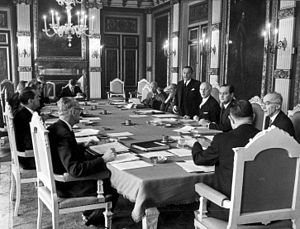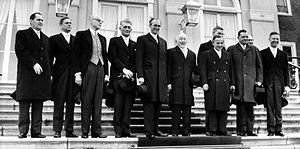- De Jong cabinet
-
 Council of Ministers of the Netherlands meeting of the De Jong cabinet in 1967.
Council of Ministers of the Netherlands meeting of the De Jong cabinet in 1967.
The De Jong cabinet (April 5, 1967 – July 6, 1971) was a Dutch centre-right cabinet with ministers from Catholic People's Party (KVP), People's Party for Freedom and Democracy (VVD), Anti Revolutionary Party (ARP) and the Christian Historical Union (CHU). It was the first Cabinet of the Netherlands after World War II that completed a full term without any internal conflicts. The cabinet was confronted with a demand for democratic reforms in the society and it decided to democratise colleges and universities after the famous maagdenhuisbezetting. Plans were made to modernise politics by establishing an electoral system with districts or a chosen prime minister, but these plans were not implemented. Meanwhile, a pay pause due to the decision of employers and employees to raise wages was partly revoked after anti-government demonstrations and strikes. The minister of economic affairs, De Block, resigned, officially as a protest against the wage rise in the metal industry, but another reason was his slow reaction to the inflation and rising prices after the introduction of Value added tax. More unrest took shape in demonstrations against the war in Vietnam. Internationally, relations with Indonesia improved, resulting in a visit by president Suharto, which was, however, overshadowed by the occupation of the Indonesian embassy by Moluccans. The Soviet Union invasion in Czechoslovakia was seen as a reason to increase the defence budget.
- As of 2011, the following cabinet members are still alive:
- Piet de Jong - April 3, 1915
- Johan Witteveen - June 12, 1921
- Roelof Nelissen - April 4, 1931
- Berend Jan Udink - February 12, 1926
- State Secretaries
- Hans Grosheide - August 6, 1930
- Anthony Duynstee - December 24, 1920
- Roelof Kruisinga - August 27, 1922
External links
- (Dutch) Kabinet-De Jong (1967-1971) (Parlement & Politiek)
Structure and process StructureGovernmentMinisters, including Ministers without Portfolio, chaired by the Prime Minister of the Netherlands and one or more Deputy Prime Minister of the NetherlandsMinisters, including Ministers without Portfolio and State SecretariesProcessCurrent ministries Cabinets Schimmelpenninck • De Kempenaer-Donker Curtius • Thorbecke I • Van Hall-Donker Curtius • Van der Brugghen • Rochussen • Van Hall-Van Heemstra • Van Zuylen van Nijevelt-Van Heemstra •Thorbecke II • Fransen van de Putte •Van Zuylen van Nijevelt • Van Bosse-Fock • Thorbecke III • De Vries-Fransen van de Putte • Heemskerk-Van Lynden van Sandenburg • Kappeyne van de Coppello • Van Lynden van Sandenburg • Heemskerk Azn. • Mackay • Van Tienhoven • Röell • Pierson • Kuyper • De Meester • Heemskerk • Cort van der Linden • Ruijs de Beerenbrouck I • Ruijs de Beerenbrouck II • Colijn I • De Geer I • Ruijs de Beerenbrouck III • Colijn II • Colijn III • Colijn IV • Colijn V • De Geer II • Gerbrandy I • Gerbrandy II • Gerbrandy III • Schermerhorn-Drees • Beel I • Drees-Van Schaik • Drees I • Drees II • Drees III • Beel II • De Quay • Marijnen • Cals • Zijlstra • De Jong • Biesheuvel I • Biesheuvel II • Den Uyl • Van Agt I • Van Agt II • Van Agt III • Lubbers I • Lubbers II • Lubbers III • Kok I • Kok II • Balkenende I • Balkenende II • Balkenende III • Balkenende IV • RutteCategories:- Cabinets of the Netherlands
- As of 2011, the following cabinet members are still alive:
Wikimedia Foundation. 2010.
















